Back to: CHEMISTRY SS2
Welcome to Class !!
We are eager to have you join us !!
In today’s Chemistry class, We will be learning about Saturated Hydrocarbons (Alkanes). We hope you enjoy the class!

CONTENT
- IUPAC Nomenclature
- Preparation, Properties and Uses.
The alkanes are aliphatic hydrocarbons. Their general molecular formula is CnH2n+2. Hence
For n=1 CH4 Methane
n=2 C2H6 Ethane
n=3 C3H8 Propane
n=4 C4H10 Butane
n=5 C5H12 Pentane and so on.
There is no functional group in the alkane series.
THE IUPAC NOMENCLATURE FOR ALIPHATIC COMPOUNDS
In IUPAC nomenclature, the name of an organic compound consists of a ROOT, SUFFIX and PREFIX names.
Root name: Name of the parent aliphatic hydrocarbon of the longest carbon chain in a molecule.
Suffix name: Name of the principal functional group on the longest carbon chain in a molecule.
Prefix name: Name of the other substituents on the longest carbon chain which are not functional groups. For example, 1- chloroethane-1-ol; has 1-chloro as prefix, ethane as root and -1-ol as suffix.
RULES FOR THE IUPAC NOMENCLATURE
- Select the longest continuous carbon chain as parent hydrocarbon.
- Number the longest carbon chain starting from the end that gives the lowest possible number to the suffix (functional group).
- Indicate the other substituents by prefixes preceded by numbers to show their position on the carbon chain.
- If the same alkyl or other substituents group occurs more than once as a side chain, show how many are present by using prefix di, tri, tetra etc. and indicate by various numbers the position of each group on the longest carbon chain.
- If there are several different alkyl groups attached to the parent chain, name them in alphabetical order.
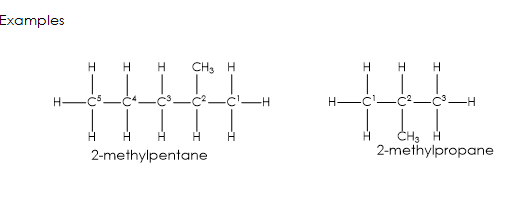
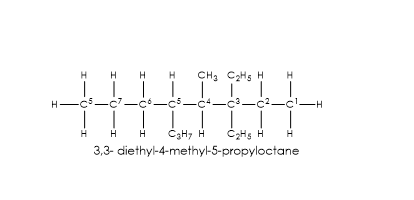
- If there are halogens together with alkyl groups attached to the parent chain, name the halogens first in alphabetical order and the alkyl group as explained earlier.
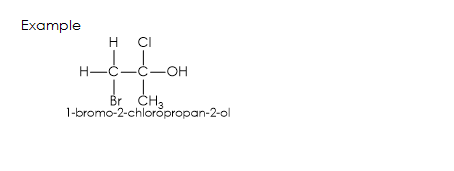
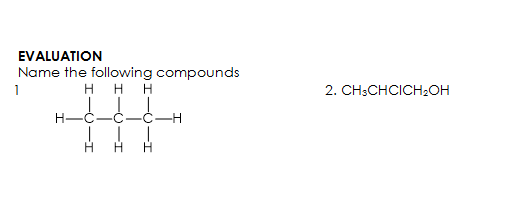
METHANE (CH4)
LABORATORY PREPARATION
Methane is prepared in the laboratory by heating ethanoate salt with corresponding alkalis e.g. sodium ethanoate and soda-lime. Soda-lime is quick lime slaked with a concentrated solution of sodium hydroxide. It is used in preference to caustic soda because it is not deliquescent and does not attack glass so readily.
PHYSICAL PROPERTIES
- Methane is a colourless and odourless gas.
- It is slightly soluble in water.
- It is less dense than air
- It has no action on litmus paper
CHEMICAL PROPERTIES
- Combustion: Methane burns in air or oxygen to produce steam, carbon(IV) oxide and a lot of heat
CH4(g) + 2O2(g) 2H2O(l) + CO2(g).
The general equation for the combustion of alkanes is represented as
CxHy(g) + ( x + y/4)O2 y/ 2H2O(g) + xCO2(g).
- Substitution reaction: Substitution reaction involves the direct displacement of an atom or group by another atom or group. Methane reacts with chlorine in the presence of ultra-violet light to yield a mixture of products.
CH4(g) + Cl2(g) CH3Cl(g) + HCl(g)
Chloromethane
USES OF METHANE
- Methane is used as fuel by itself or mixed with other gases.
- It is used for making hydrogen gas.
- It is used in making carbon black.
- Trichloromethane is used in surgical operations as an anaesthetic.
Evaluation
- Describe laboratory preparation of methane.
- Write two equations to show the chemical properties of methane.
Isomerism
This is the existence of two or more organic compounds with the same molecular formula but different molecular structures.
TYPES OF ISOMERISM
- Structural Isomerism
- Stereoisomerism.
The structural isomerism occurs in organic compound with the same molecular formula but different structural arrangement of the carbon atom.
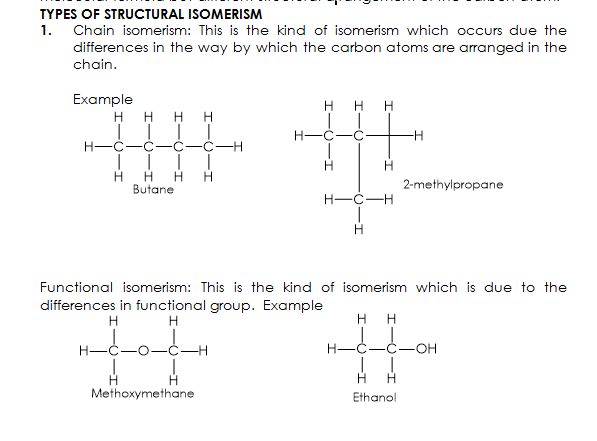
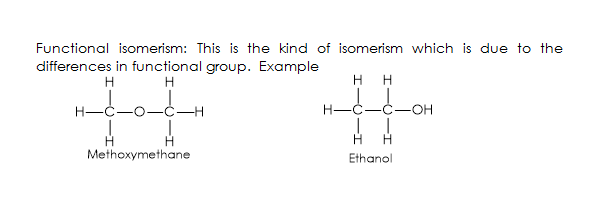

STEREO ISOMERISM: This arises as a result of differences in spatial orientation of atoms or groups of atoms about a carbon-carbon double bond or ring structure or a carbon atom surrounded by four different groups.
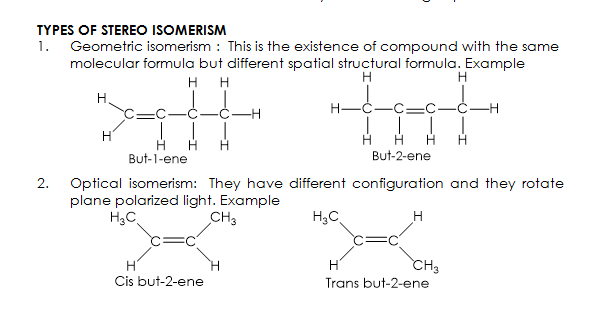
GENERAL EVALUATION/REVISION
1. Give the structure of the following organic compounds:
- 1-chloro-2-methyl pentane
- 2,2,4-trimethyl hexane
- 1-bromo-2-methyl butane
- What is meant by the term isomerism?
- Draw the structure of the two isomers of the compound with the molecular formula C2H6O. Give the name of each of the isomers.
- State the major difference between the isomers.
- Give the two reasons why soda-lime is used instead of caustic soda in the laboratory preparation of methane.
READING ASSIGNMENT
New School Chemistry for Senior Secondary School by O.Y. Ababio(6th edition) Pages 520-525, 530-532
Weekend Assignment
SECTION A: Write the correct option ONLY
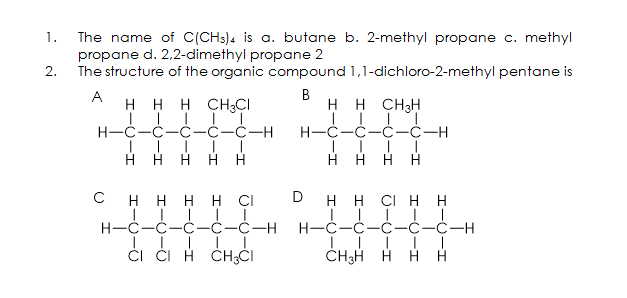
- The carbon atoms in alkanes are not hybridized b. sp3 hybridized c. sp2 hybridized d. sp hybridized
- The general formula for the alkanes is a. RCHO b. CnH2n+1 CnH2n+2 d. RCOOR
- C4H10 belongs to the same homologous series as a. C4H8 C2H2 c. C3H8 d. C5H10
SECTION B
- Define the term isomerism
- Name the alkanol that is isomeric with Methoxy methane (CH3OCH3)
a. Name the following compound:(i) CH3(CH2)3CH3 (ii) C2H4Cl2
3. Write the structure of the following compounds
(i) 1-methyl cyclopropane (ii) 2-bromo-4-methyl pentane
We have come to the end of this class. We do hope you enjoyed the class?
Should you have any further question, feel free to ask in the comment section below and trust us to respond as soon as possible.
In our next class, we will be learning about Unsaturated Hydrocarbons. We are very much eager to meet you there.

thanks for todays teaching nice one 😀
keep it up